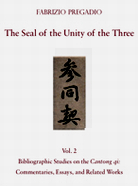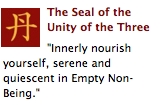The Seal of the Unity of the Three (Cantong qi)
Commentaries and Editions (Part 1)
Fabrizio Pregadio
These materials on the The Seal of the Unity of the Three, the main text of Taoist Internal Alchemy, are selected from:
Fabrizio Pregadio
Golden Elixir Press, 2011
Paperback
Part 1 of this book contains a bibliographic catalogue of about 150 extant and lost commentaries, essays, and other works related to the Cantong qi, with details on authors, dates, editions, and reprints. Part 2 contains a survey of the textual tradition of the Cantong qi, focused on the composition and contents of about 40 major texts.
 This page is part of a series on the Seal of the Unity of the Three. See the complete index.
This page is part of a series on the Seal of the Unity of the Three. See the complete index.
NOTE: This article contains notes on 28 of the 34 extant premodern commentaries of The Seal of the Unity of the Three. Commentaries are numbered according to numeration found in The Seal of the Unity of the Three, Vol. 2.
(1) Anonymous
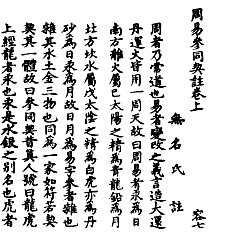
Zhengtong Daozang ed., 1445
Zhouyi cantong qi zhu 周易參同契注, ca. 700
Commentary on The Seal of the Unity of the Three
While Peng Xiao's commentary (no. 3 below) has often been called the earliest extant exegesis of the Cantong qi, Chen Guofu 陳國符 was the first scholar to show that the anonymous Zhouyi cantong qi zhu dates from between the late-seventh and the mid-eighth centuries.
The single extant edition of this work, found in the Taoist Canon (Zhengtong Daozang 正統道藏, 1445), contains only the first of the three Books (pian) in which most other redactions are arranged. Internal evidence shows that it originally included the whole text of the Cantong qi.
This is the only extant commentary that contains a Waidan interpretation of the Cantong qi. It presents a somewhat unrefined state of the text, which is not yet divided into sections and contains more references to Waidan compared to the later redactions, where certain Waidan terms are replaced with different terms.
![]() The Seal of the Unity of the Three, Vol. 2, pages 22 and 112-114
The Seal of the Unity of the Three, Vol. 2, pages 22 and 112-114
(2) Yin Changsheng 陰長生 (attr.)
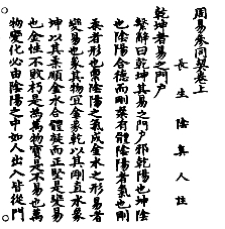
Zhengtong Daozang ed., 1445
Zhouyi cantong qi 周易參同契, ca. 700
The Seal of the Unity of the Three
Not long before or after the year 700, another anonymous author wrote the second Tang commentary of the Cantong qi. Attributed to the legendary immortal Yin Changsheng, this commentary is distinguished by a cosmological interpretation, but contains incidental references to Waidan practices.
The text at the basis of this commentary is closely related to the text found in the anonymous Waidan commentary (no. 1 above). Taking as a unit the single verses of the Cantong qi, the Yin Changsheng and the anonymous redactions together diverge more than 150 times from the text established by Peng Xiao about two centuries later (no. 3 below). About two thirds of these variants are shared by both works, which in many other instances differ from one another only in minor details.
Like the anonymous Waidan commentary, the Yin Changsheng commentary is only preserved in the Taoist Canon (Zhengtong Daozang 正統道藏, 1445).
![]() The Seal of the Unity of the Three, Vol. 2, pages 23 and 115-16
The Seal of the Unity of the Three, Vol. 2, pages 23 and 115-16
(3) Peng Xiao 彭曉 (?-955)
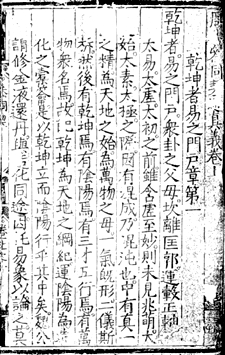
Jindan zhengli daquan ed., 1538
Zhouyi cantong qi tong zhenyi 周易參同契通真義, 947
The True Meaning of The Seal of the Unity of the Three, with a Subdivision into Sections
The commentary by Peng Xiao contains the first extant interpretation of the Cantong qi as a Neidan work. Peng Xiao submitted the Tang text of the Cantong qi to a substantial rearrangement. He divided it — mainly on numerological grounds — into 90 sections; he placed the "Song of the Tripod" ("Dingqi ge" 鼎器歌) in a separate "book" (pian); and he appended a section entitled "Chart of the Bright Mirror" ("Mingjing tu" 明鏡圖) to the third and final chapter of his commentary.
Comparison of his text with the two earlier Tang redactions shows that the variants introduced by Peng Xiao consist of several inversions and relocations of verses, and of a large number of substitutions of single words. The exact extent of these innovations, however, cannot be easily ascertained. In 1208, the astronomer Bao Huanzhi 鮑澣之 produced what he thought would be a critical edition, incorporating several dozen readings drawn from Zhu Xi's redaction into Peng Xiao's text. Since these readings are found in all extant editions of Peng Xiao's work, none of them preserves his original text.
The page shown here is reproduced from Jindan zhengli daquan 金丹正理大全, a compilation of eleven Neidan texts first published in 1538.
![]() The Seal of the Unity of the Three, Vol. 2, pages 23-28 and 120-25
The Seal of the Unity of the Three, Vol. 2, pages 23-28 and 120-25
(4) Zhu Xi 朱熹 (1130-1200)
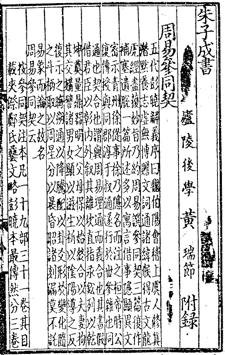
Zhuzi chengshu ed., 1341
Zhouyi cantong qi 周易參同契, 1197
The Seal of the Unity of the Three
The best-known commentary of the Cantong qi outside the Taoist tradition was composed by Zhu Xi. Usually known as Zhouyi cantong qi kaoyi 周易參同契考異 (Investigation of Discrepancies in The Seal of the Unity of the Three), this is the first of several works, written through the Qing period, that testify to the attention paid by Neo-Confucian thinkers and scholars to the Cantong qi. It is also the work that more than any other lifted the Cantong qi out of an exclusive relation to Taoism.
The Kaoyi was first published in 1198, soon after its completion. Later, in the first half of the 14th century, it was edited by Huang Ruijie 黃瑞節, who included it in his Zhuzi chengshu 朱子成書, an early collection of Zhu Xi's works published in 1341. This is the earliest extant edition of Zhu Xi's commentary. Huang Ruijie supplied additional notes consisting of his own comments and of quotations drawn from other works by Zhu Xi.
In clear contrast with its title, and with Zhu Xi's own statements about his philological work found in his preface and postface, the commentary contains only a handful of critical notes. Internal and external evidence suggests that a number of critical notes were expunged either by Huang Ruijie or by an earlier, unknown editor.
![]() The Seal of the Unity of the Three, Vol. 2, pages 29-34 and 137-42
The Seal of the Unity of the Three, Vol. 2, pages 29-34 and 137-42
Next: Part 2 ▶
© 2023 Fabrizio Pregadio and Golden Elixir Press



